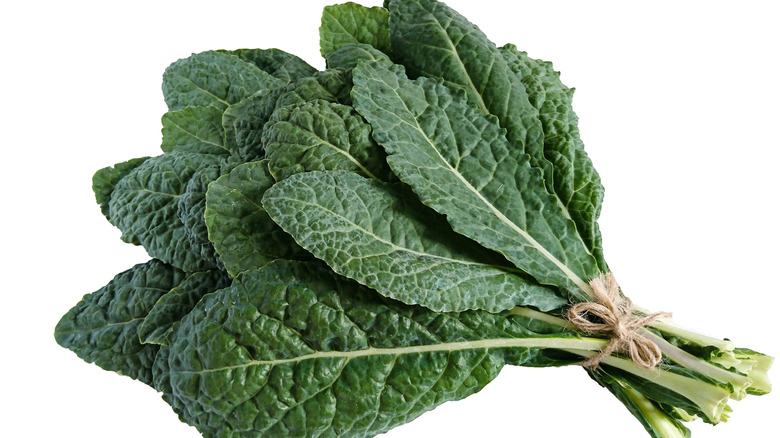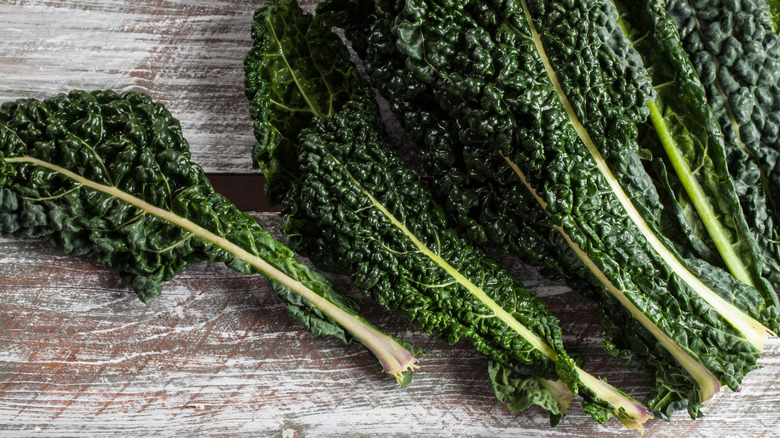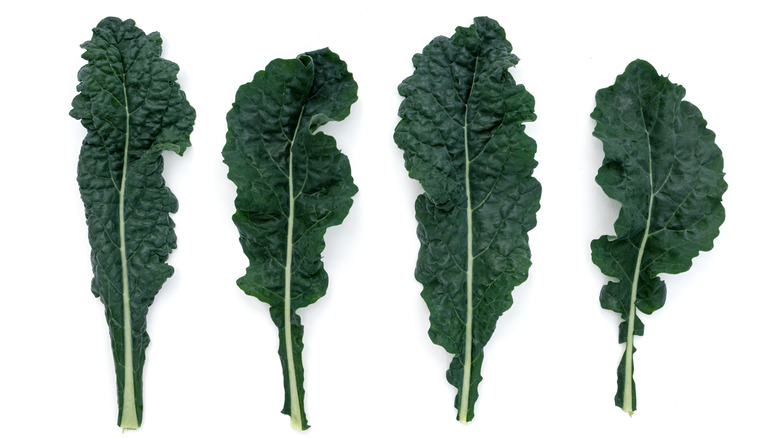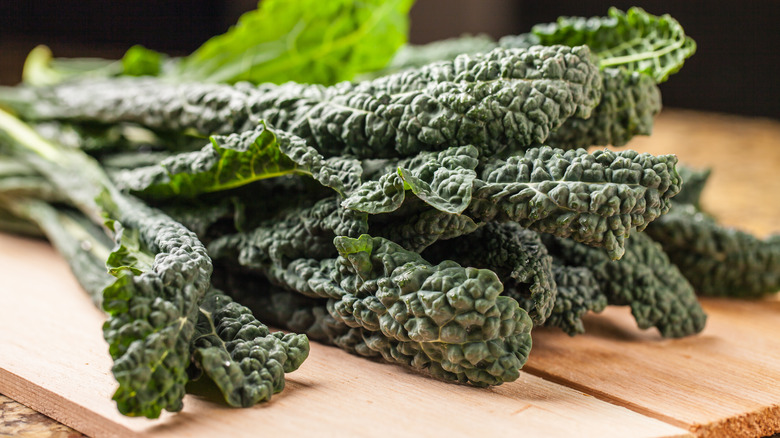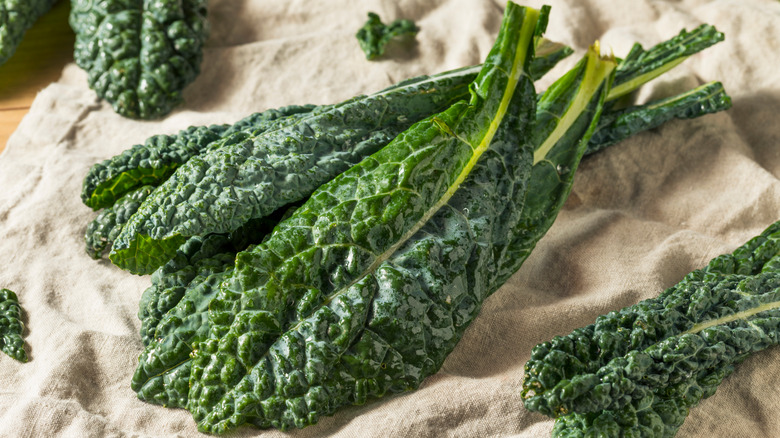What Is Dinosaur Kale And Can You Eat It Raw?
Have you ever eaten dinosaur kale? Although the name of this cruciferous leafy vegetable might sound odd, it's actually an extremely common — and very tasty — variety of kale (via The Spruce Eats). A kale of many names, Brassica oleracea (variety acephala) is also known as lacinato kale, Tuscan kale, Italian kale, and cavolo negro, or "black cabbage" in Italian. According to Gardener's Path, dinosaur kale originated in and has long been popular in Italy, hence its Italian name variations, and this kale is often found in delicious Italian dishes such as minestrone and ribollita. So why the name "dinosaur kale," then? Simple: the kale's dark green, bumpy, crinkled texture resembles reptile skin.
A member of the brassica family, and thus related to cabbage, broccoli, and bok choy, dinosaur kale is a versatile and delicious vegetable. Read on to learn more about dinosaur kale and how to prepare it.
What is dinosaur kale?
Dinosaur kale, also known as lacinato or Tuscan kale, is a dark blue-green, leafy variety of kale whose bumpy texture resembles that of "dinosaur" skin (via Gardener's Path). This kale grows on an upright plant, forming long, narrow, oval-shaped leaves that can reach sizes of more than 18 inches; however, it's best to select leaves of this size or shorter, in order to enjoy this kale at its most tender and least bitter (via The Spruce Eats).
An heirloom varietal with a long history, dinosaur kale was first cultivated in Italy as far back as the 18th century (via Burpee). Thomas Jefferson, the third U.S. president and a lover of agriculture, actually grew dinosaur kale in his extensive gardens at Monticello, according to Burpee Seeds. In other words, dinosaur kale has a long history in the United States, even though it might seem unfamiliar to some.
Dinosaur kale vs. other types of kale
Even if you're a bonafide lover of kale, you may not have tasted all the varieties out there: this leafy green comes in a staggering amount of types. According to Gardening Chores, there are at least 12 varieties of kale, including curly, Red Russian, Chinese, Redbor, Siberian, and Walking Stick kale.
Typically, different types of kale vary primarily in their texture. Curly kale, for example, features intricately curled leaves, while Chinese kale has large, flat leaves that more closely resemble those of its cabbage cousin (via Gardening Chores). Dinosaur kale falls somewhere in between, with long, flattish leaves that nevertheless have a raised, scale-like texture to them (via Gardener's Path). While some kale varieties can have a bitter taste, dinosaur kale is typically mild in flavor (via The Spruce Eats), and it also maintains its texture when cooking, making it an excellent choice for dishes in which you want to maintain the leaves' integrity, such as stuffed kale rolls.
How to cook with dinosaur kale
Dinosaur kale is a versatile leafy green that works well in a variety of recipes and can also be eaten raw (via The Spruce Eats). Due to dinosaur kale's textured leaves, you'll want to give it a rinse or a quick soak to remove any trapped dirt before cooking. The leaves have a prominent stem running down the center; with smaller, more tender leaves, you can leave the stem in, but you'll want to remove it from largier, sturdier leaves, as it can remain tough throughout cooking (via The Spruce Eats).
Once your kale is prepped, you can include it in a variety of recipes, from a simple sauté to traditional Tuscan dishes such as ribollita. Owing to its sturdy texture, dinosaur kale is a wonderful addition to braises, soups, and stews, and it's also excellent in kale salad – just make sure to prep the kale by massaging it with acid and salt, which will help break down any toughness and leave the kale nice and tender.
Where to buy dinosaur kale
Dinosaur kale has been growing in popularity in recent years and can typically be found in the produce section of large, well-stocked grocery store chains. According to The Spruce Eats, dinosaur kale's growing season runs from November through the spring, so you'll want to look for it during the winter. In those months, dinosaur kale can also be found in local farmers markets.
When selecting dinosaur kale, look for glossy leaves without any brown spots, wilting, or damage from insects (via The Spruce Eats). To ensure the best flavor, choose leaves that are no more than 18 inches in length; any bigger, and the kale can start to taste bitter or have a tough texture.
To store kale, wrap bunches loosely in a plastic bag or dish towel and stash them in the fridge for up to a week (via The Spruce Eats). Do not wash the greens first; dinosaur kale actually lasts longer when it's dry. Dinosaur kale also freezes wonderfully. You'll want to prep the kale first by rinsing it, cutting out the ribs, giving it a rough chop, blanching it briefly in boiling water, then squeezing out the excess moisture before cooling it completely and packing it loosely into freezer bags (via The Spruce Eats). Stored this way, dinosaur kale should last up to a year in the freezer, and can easily be added to soups, stews, or even smoothies.
Dinosaur kale nutritional information
Like many other leafy greens, dinosaur kale is a super healthy option and a great way to boost your intake of vitamins and minerals. According to dinosaur kale grower Cal-Organic, dino kale is low in calories and high in fiber, and can support healthy digestion, metabolism, bone and joint maintenance, and vision. An 85-gram serving of dinosaur kale contains just 20 calories, no fat, just four grams of carbohydrates, one gram of fiber, and two grams of protein (via Cal-Organic). It's a rich source of calcium, providing 220 milligrams (or 15 percent of the daily allowance) of this vital mineral, as well as 1.4 milligrams of iron and 300 milligrams of potassium. According to Cal-Organic, dinosaur kale is also high in sulfur, a mineral which supports many of the body's functions, including the making and repairing of DNA (via Healthline). Delicious and nutritious, dinosaur kale is an excellent addition to any dinner table.
